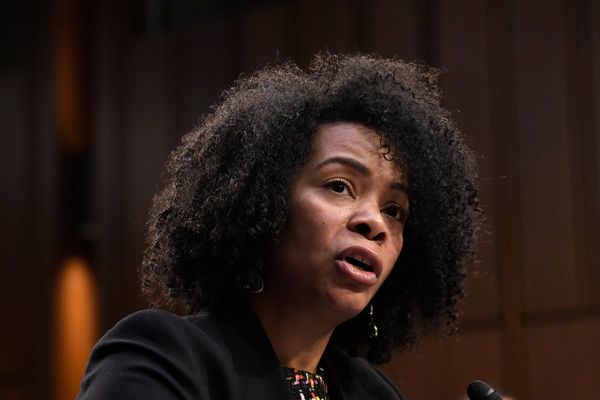
KABUL, Afghanistan—In the last three weeks, Bibi Koh has lost at least three family members to renewed fighting between Taliban and Afghan forces in the southern province of Helmand. Three weeks ago, her oldest brother was killed in the crossfire between the warring sides. A few days later, her two sons, aged six and eight, went missing.
“I don’t know where they went. I don’t know if someone took them,” Bibi said. The ongoing clashes between the Taliban and government troops made it impossible to search for them, but not to keep her three remaining children safe. Last weekend, she gathered the last money she had left—about $60—and brought her family to a makeshift refugee camp in Kabul by way of Helmand’s neighboring province, Kandahar.
The travails of Bibi Koh and her children are common at Camp Shina, an informal settlement on the eastern outskirts of the capital that houses more than two dozen Helmandi families that have arrived in the last week. All the arrivals—mostly widows with children—have lost family members in recent fighting; the men who stayed behind are unreachable thanks to spotty telephone service.
“We don’t know if they’ve been martyred or if they fled, too. We just have to hope for the best,” said another mother in the camp.
Camp Shina and the ongoing battle for Helmand are emblematic of the many challenges Afghanistan continues to face as U.S. President Donald Trump pushes for a complete withdrawal of U.S. forces by the end of the year. His Democratic rival, Joe Biden, also favors pulling out, as does the American public.
With the presidential election fast approaching, and with peace talks between the Taliban and the Afghan government staggering forward, Helmand has become a dark reminder of the cyclical nature of the Afghan war—and just how delicate the security situation remains. Ten years ago, more than 15,000 Afghan, U.S., British, Canadian, and Estonian troops made one of the biggest pushes of the war to dislodge the Taliban from the town of Marjah, then the Taliban’s last big stronghold in Helmand.
By the end of the year, it was clear the military surge in Marjah had failed. By the end of the decade, it was clear all the efforts to wrest Helmand, the biggest poppy-producing province in Afghanistan, from the Taliban had also failed. Various districts and villages in Helmand have been at the past five.
And yet, despite—or because—of those failures, the United States is racing for the exit. Trump says he wants the troops home by Christmas. The chairman of the joint chiefs of staff, however, has made no statements confirming a set date for the U.S. withdrawal, saying instead that Washington should responsibly end the war in Afghanistan. As of last month, Joe Biden was also in favor of a U.S. pullout, but with the caveat that any withdrawal also have a plan for taking on Islamic State forces in the country.
The mixed messages coming out of Washington have also tested the patience of officials in Kabul. After years of certainty that their country was too strategic for the United States to abandon once again, the Afghan government is now toiling away at plans for a potential American exit.
A security source in Kabul said the recent upsurge in violence across the country, including in Helmand, is further evidence that the United States must reveal its plans for the country.
“They can stay or they can go, but whatever they’re going to do, they need to decide for themselves. We are already preparing for our future, even with the zero presence and support,” the source said.
Regular Afghans are left wondering, too.
This month’s offensive in Helmand has already led to the displacement of at least 35,000 families within the province, with thousands more pouring into Kandahar and Kabul. The Helmandis in Kabul say those who remain in the province are literally caught in the crossfire between Afghan and Taliban forces.
“They are shooting blindly; people are being killed on their farms and in their homes. I can’t tell the Afghan army not to shoot at us and I can’t tell the Taliban not to shoot at us,” said Malek Abdul Mohammad, who brought his family to Kabul.
It’s not a lot easier in the camps near Kabul. Most are living in simple, makeshift tents erected on top of dirt fields. “Our children are left freezing at night without blankets,” said Bibi Koh. Her youngest son was in first grade in Helmand, even though sporadic fighting and financial limitations made it tough for him to attend classes. Seeing his potential, they pushed him to attend. “He’s my smart boy,” Bibi Koh said, looking at her son. Now, in a camp, he’s out of school—like another 3.7 million Afghan children.
But simply getting out of Helmand was hard enough. Siya Moi, who brought her four children to Kabul, says there were bullets flying almost the entire way to Kandahar.
“At the checkpoints they would try and wave you through quickly to make sure women and children weren’t killed in the gunfire, but what can they do?” she said.
Bibi Koh recalls the road to Kandahar as particularly harrowing.
“The driver had to drive through fields and side roads, because the Taliban were planting mines on the main roads,” she said of the journey. Over the last several months, roadside mines have become an even more prevalent tactic employed by the Taliban across the country. In August, Afghan President Ashraf Ghani made a plea to the group, asking them to halt their use of such devices, which he called “the main cause of civilian casualties” in the country.
The Taliban’s latest effort to capture Helmand, along with its stepped-up use of roadside bombs, has shaken people’s confidence in the peace process. Since August, the Afghan government has been meeting with the Taliban in Doha, Qatar, trying to chart a future for the country after four decades of war.
“All we want is peace, an end to the fighting, but what can we tell those sitting in Doha to do? We are the ones paying the price,” said Siya Moi.







